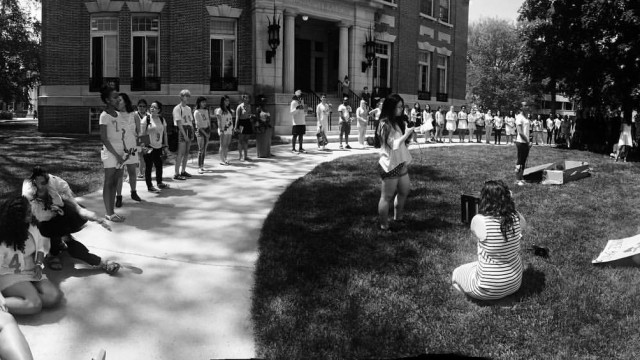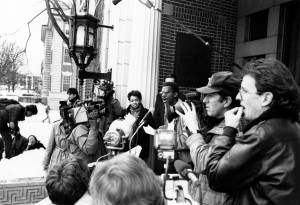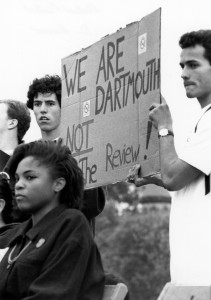
Mistreatment of Faculty of Color
Caption: 2016 procession on Parkhurst lawn in honor of the 36 professors of color who have left Dartmouth College in the last 14 years; picture taken by Kevin Bui ’17
Currently, Dartmouth has the least diverse faculty in the Ivy League with only 14.7% of faculty identifying as a minority group. Of tenured professors, only 12% identified as minorities. Only 37% of Dartmouth faculty are women. Statistics found are only binary and not intersectional– for example, there are no statistics on the percentage of Dartmouth faculty who are women of color. Dartmouth has been called out for its mistreatment of and lack of support for faculty of color ever since March 1969, when the Afro-American Society presented a list of demands that included a call for more faculty of color.
Recently, students have rallied around the case of Aimee Bahng, an English professor who was denied tenure despite a unanimous department vote for approval. This rally was also the result of the frustration developed from the leave of 36 other professors of color in the past fourteen years. These professors include Derrick White and Sharlene Mollett, who were both denied tenure despite a unanimous vote of approval but their respective departments.
The College claims to evaluate faculty based on the “quality” of their work, such as intellectual publications and scholarships, but doesn’t care for other factors such as their contributions to the experience and inclusion of students of color. It also doesn’t take into consideration how a lack of senior faculty of color can hinder the transition into research and writing as faculty enter academia. This obstacle is further exacerbated in non-mainstream fields that are already devalued when tenure decisions are made. Unfortunately, this is not the first case in which the College has shown a lack of support for professors of color.
In the late 1980s, students rallied around Dartmouth music professor, William Cole. Professor Cole is a Black musician with a Ph.D. from Wesleyan University and has written multiple scholarly publications. Beyond that, he always took the extra step to connect with his students by visiting them and making time for them outside the classroom. In 1988, his ability to connect with students on a more personal level was restrained after the Dartmouth Review claimed he was on drugs during class, an unsupported claim, and condemned his teaching methods. The tension resulted in a confrontation on February 25, 1988 in which members of the Review’s staff persisted in an abusive oral exchange despite Professor’s Cole’s requests for them to leave the room. The confrontation culminated in the suspension of two students, yet they were soon reinstated by court order, revealing how systemic racism does not stop with the college but continues into the criminal “justice” system.
The administration’s gross mistreatment of faculty of color reveals not only a disregard of faculty but also a disregard of students of color, their continuous demands for increased faculty diversity and the value of faculty of color in challenging racist campus attitudes.
For further reading:
At Dartmouth the Clash of ’89 by John Casey
Black Intellectual Lives Matter by Derrick White
Students and faculty react to Bahng’s denial of tenure by Carter Brace
- Faculty Race Diversity
- Faculty Gender Diversity
Disclaimer: all photos from Dartmouth College Rauner Special Collections Library unless otherwise noted



